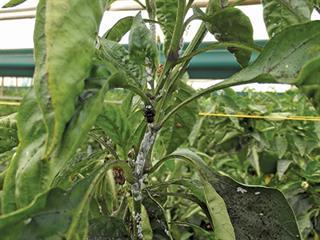
The first, which needs no introduction, is cutworm. It is a threat to all vegetable crops and has been mentioned in a previous article.
Here are some others:
- African bollworm – This is not normally a serious pest but it can be a problem on occasion. Along with several other caterpillar species, it will first be discovered eating the leaves. At this stage, it is easily controlled by pesticides, but I recommend using a biological product that targets caterpillars and does not harm beneficial insects that may control other pests. When caterpillars start attacking the fruit, they become very difficult to control as they enter the fruit and eat it from within. It’s therefore essential to monitor the crop frequently in order to deal with caterpillars before this stage.
- Aphids – These can be a nuisance from time to time, especially when the crop is grown under protection. Ladybirds and other aphid predators can bring them under control, but not always. Even a small population can be a threat. You might find a few aphids, notice that you have ladybirds and leave them to take care of the aphids. This can work, provided there’s no virus threat. If there is a virus present, don’t take a chance: aphids spread viruses. The usual aphid found in peppers is pale yellow, small and rather inconspicuous. The first signs of its presence are yellowing leaves and the presence of honeydew, which may later turn black due to a fungus called sooty mould. Ants will farm the aphids for their honeydew and protect them from the insects that usually control the aphids.
- Spotted maize beetle – This appears at Christmastime in certain areas and is often referred to as a ‘pollination beetle’ because it consumes large amounts of pollen. It is often seen on maize tassels, where it may be present in such numbers that it can cause serious pollination problems. It even chews the sticky stigmas to get at the pollen adhering to them. If spotted maize beetles arrive in numbers, apply a contact insecticide to smaller operator, put out a number of small tubs painted a bright yellow and half fill them with water. The beetles will drown in them, mistaking them for large yellow flowers. The larvae are tough, hairy caterpillars that operate just at or under ground level, where they can damage tender seedlings. By controlling the adults, you can drastically reduce the population the following season.
- Mealy bug – This is a pest that seems to be more common nowadays. It is a waxy white insect that is extremely difficult to control with crop chemicals and is best controlled by natural predators. A number of ladybird species attack it but there is one ‘specialist’ that does an especially good job. This is the Cryptolaemus or ‘crypto bug’. This small black ladybird with a red head is available from Koppert.
- Mites – These can become a problem, especially in hot, dry conditions. Look for small lightlycoloured specks on the upper side of leaves. Turn them over and you’ll see the mites feeding on the underside. A number of effective systemic products are available for its control.
- Eelworm – Capsicums are susceptible to eelworm. Examine the roots of the crop planted before the peppers to look for the presence of this pest. If necessary, treat the soil before planting capsicums.
- Rodents – These can cause a great deal of damage, which is often not seen until it becomes excessive. They are not affected by hot chillies either. If you notice rodent burrows in the land before preparation, rather fumigate with Phostoxin tablets immediately than try to control them later.












